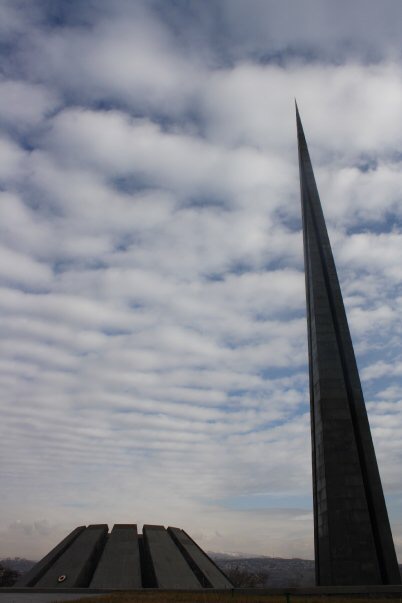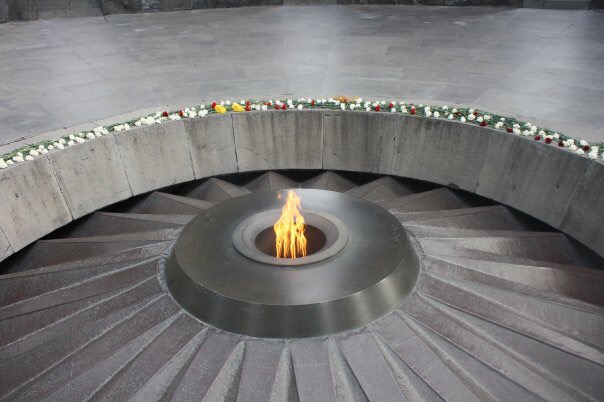The following is an abridged and updated version of a chapter in ‘Literary Ark 2014: Armenia Hosts Literature’ (Yerevan, AOKS, 2015).
Lead Up to 100th Memorial Year

‘As I stood on these dark stone steps at Tsitsernakaberd, I was surrounded by hundreds of thousands of mourners from around the world.’ (Photo: Rupen Janbazian)
I am the grandson of an orphan of the 1915 genocide. Several years ago, I thought about what I should do as 2015, the 100th memorial year of the Armenian Genocide, approached. As a political historian, how could I contribute in that historic year of remembrance and further educate the world and ourselves about the genocide? Little did I know that instead of writing a few journalistic articles and chapters in academic books about the Armenian Genocide, I would embark on a more challenging odyssey. Early in 2012, I was invited by Holocaust scholar and rabbi professor Steven Jacobs, working with the major American publisher ABC-CLIO, to contribute to a new online genocide encyclopedia that later became the four-volume Modern Genocide: The Definitive Resource and Document Collection (2014). I would write entries on the Armenian Genocide for both versions. Soon thereafter, a much more monumental task arose. For the next three years, I edited and wrote entries for a related volume. It was to be the first-ever encyclopedia on the Armenian Genocide with the publication date goal of 2015. The Armenian Genocide: The Essential Reference Guide emerged as a 425-page major volume that included 7 overview essays, 150 subject entries, a detailed chronological timeline, maps, photographs, and an extensive selection of key documents (including portions of the British government’s official 1916 report. The Treatment of the Armenians in the Ottoman Empire; American Ambassador Morganthau’s memoirs; and 1915 press reports from the New York Times).
Literary Ark Writers’ Workshop and the Global Forum
While working on the encyclopedias, I received an invitation to participate at the Yerevan Literary Ark Festival in April 2015. This was an ideal opportunity to share with other writers our reflections on the Centennial of the Armenian Genocide. The Literary Ark Festival took place for 10 days and overlapped with the two-day Global Forum Against the Crime of Genocide that was held at Yerevan’s great hall of the Sports and Concerts Center. On the two sides of the plenary hall were various displays about the Armenian Genocide. The National Library mounted a major book display, organizing the sections by country of origin of publication. It was quite a revelation for me to see so many books, some for the first time.
During a brief break in the Global Forum, President Serge Sarkisian visited the book display. I had a few moments to talk with him about my books and gave the president a copy of Just Poems: Reflections on the Armenian Genocide, along with Return to Armenia/Veradardz depi Hayastan. I also showed him the mock-up of the new Armenian Genocide encyclopedia.
Resurgence of the Diaspora

‘Several years ago, I thought about what I should do as 2015, the 100th memorial year of the Armenian Genocide, approached.’ (Photo: Rupen Janbazian)
As I listened to the various speakers during the 10-day Literary Ark seminar, I wondered if the Young Turk dictators of 1915 had projected that virtually none of the elderly and orphaned Armenians would survive. No doubt, the Turkish triumvirate arrogantly believed that the elderly Armenians would surely soon perish and the orphans would rapidly disappear through assimilation. History, however, can unfold in complex and ironic ways. Many Diaspora Armenians, often from mixed marriages, who in their youth might have wished to assimilate and “fit in” to their new society, have in their later years sought to seek out and explore their Armenian identity.
Thus, on the eve of and during the Centennial year of 2015, we have witnessed a renaissance of Armenian writings, particularly on genocide-related themes. For example, we can read historical novels by Chris Bohjalian, Sandcastle Girls, 2012; and Dana Walrath, Like Water Like Stone, 2014. We also note the following journalistic and academic volumes by Meline Toumani, There Was and There Was Not, 2014; Eric Bogosian, Operation Nemesis, 2015; Vicken Cheterian, Open Wounds: Armenians, Turks and a Century of Genocide, 2015; Mathew Karanian, Historic Armenia After 100 Years, 2015; Mariam Mesrobian MacCurdy, Sacred Justice: The Voices and Legacy of Operation Nemesis, 2015; Armen T. Marsoobian, Fragments of a Lost Homeland: Remembering Armenia, 2015; Rubina Peroomian, The Armenian Genocide in Literature: The Second Generation Responds, 2015; Ronald Suny, ‘They Can Live in the Desert but Nowhere Else’: A History of the Armenian Genocide, 2015; and Alan Whitehorn, ed., The Armenian Genocide: The Essential Reference Guide, 2015. The diaspora literary and academic voices are very much alive and growing.
From Academic to Poet and Back Again
In teaching university courses on comparative studies of genocide, it is crucial to be able to explore and develop advanced analytical and theoretical frameworks. After several weeks of teaching such diverse models, inevitably the senior students ask for a summary. After one very long evening class, I tried to pen a one-page synopsis. The already compacted and dense draft page was a complex piece of prose, but the early contours of a poem could be seen. As I went into heavy editing, I stripped down the text to its essence. In a minimalist fashion, all unnecessary descriptors and connectives were pruned. What remained was a stark, minimalist poem—one word per line—but which in only a few key words captured the essence of the various phases of genocide. The poem was composed of a series of malevolent verbs. A university course on genocide had given birth to a new poem, the “Verbs of Genocide.” It has been several years now since the poem was published in Return to Armenia/Veradardz depi Hayastan and elsewhere. It has also been read at Armenian community gatherings and even recorded on YouTube by Armenian-Canadian students.
As I listened to the various speakers during the 10-day Literary Ark seminar, I wondered if the Young Turk dictators of 1915 had projected that virtually none of the elderly and orphaned Armenians would survive. … History, however, can unfold in complex and ironic ways. Many Diaspora Armenians, often from mixed marriages, who in their youth might have wished to assimilate and ‘fit in’ to their new society, have in their later years sought to seek out and explore their Armenian identity. Thus, on the eve of and during the Centennial year of 2015, we have witnessed a renaissance of Armenian writings, particularly on genocide-related themes.
About a year ago, one of my translators told me that a German editor/publisher, who had done significant outreach work on genocide with young students, had used my “Verbs of Genocide” poem in some of his workshops. Jurgen Jankovsky had not only used the poem as a key introductory overview piece in a collection of children’s accounts about genocide, but he had chosen to use the poem’s two closing lines “Verleuegnet…Vergessen?” (Denied…Forgotten?) as the title of the newly edited German volume.
April 24 and Families Mourning and Remembering
April 24th is a unique date in the Armenian calendar. Almost all normal commercial activity in Yerevan, the capital city, comes to a complete halt. Much of the downtown traffic is either totally blocked off or dramatically altered to allow the hundreds of thousands of pilgrims to walk kilometers up the steep hill to Tsitsernakaberd Park, where the Armenian Genocide Memorial monument and flame are located. Whether rain or shine, wave after wave of extended families, entire school classes of students, organized groups of Armenian citizens, foreign student diaspora delegations, and even some visiting scholars and tourists line up patiently for hours. Slowly the mass of the Armenian nation inches solemnly towards the massive grey stone memorial. Near the end of the procession, each person on the pilgrimage usually acquires a flower, often a tulip, to lay with loving respect in a circle around the eternal memorial flame.

‘And so on a wet, windy day, I bow my head at the memorial flame and shed a tear of both sadness and joy. Metzmama, we remember. We remember.’ (Photo: Rupen Janbazian)
I am always in awe at the vast wave of the humanity peacefully making its collective homage to those who perished in the 1915 deportations and massacres. On this day, nothing else matters and the Armenian nation is united as one in remembering and seeking long overdue recognition and justice. As a member of the Armenian Diaspora, I am always humbled by this profound moment of solidarity with both our ancestors and with one another.
When I went back to the Armenian Genocide Memorial site a day later on April 25 of last year, I was struck by how the long lines had remained. Armenians were still waiting patiently. They stretched as far as my eye could see. Twenty-four hours after the official dignitaries had left, the Armenian people were still waiting to show respect. The spirit of “we remember” continued to prevail.
Remembering Metzmama on April 24th
As I stood on these dark stone steps at Tsitsernakaberd, I was surrounded by hundreds of thousands of mourners from around the world. There was a collective sense of enormous grief amongst Armenians, particularly in that historic 100th memorial year of 2015. Our parents and grandparents had endured so much terrible and unnecessary suffering. However, there was also a feeling of pride that the Armenian people have survived—not only survived, but throughout the diverse diaspora and the Republic of Armenia, we have rebuilt our family lives.
A great many of us owe our very existence to those brave few who helped the so many emaciated orphans. On the very special historic day of April 24, I think of my metzmama, my grandmother, and what enormous suffering she endured for so many years in one refugee camp and orphanage after another. But she possessed a remarkable will to survive, a passionate desire to live a life full of love and joy and to raise her own family.
This journey that I travel is very much inspired by her. I owe it to tell her story and that of the so many other countless orphans of the genocide. And so on a wet, windy day, I bow my head at the memorial flame and shed a tear of both sadness and joy. Metzmama, we remember. We remember.
Source: Armenian Weekly
Link: Remembering April 24: A Personal Odyssey
